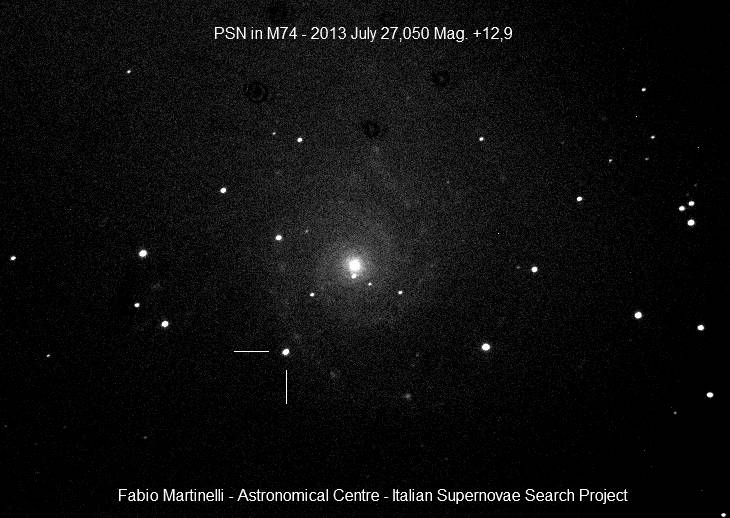Universe Today | Bob King | 2013 Jul 27
I love this galaxy. Not only does M74 display a near perfect spiral form but if this latest supernova is the third to “go boom” in the galaxy in just 11 years. The new object, designated PSN J01364816+1545310, was discovered blazing near 12.4 magnitude by the Lick Observatory Supernova Search at Lick Observatory near San Jose, Calif. “PSN” stands for “possible supernova” and the long string of numbers give the object’s position in the sky using the celestial equivalents of latitude and longitude.
- [i]One of the first photos of the new supernova (at tick marks) in the nearby galaxy M74 taken by the Italian Supernova Search Project. The object is located 93″ east and 135″ south of the galaxy’s center. Credit: [/i][url=http://www.flickr.com/photos/snimages/9375143127/][b][i]Fabio Martinelli[/i][/b][/url]
The Lick search uses a fully robotic or automated 30-inch (76 cm) telescope dedicated to scanning the skies for new supernovae. It nailed M74′s latest exploding star on July 25. Two previous supernovae flared in the galaxy - SN 2002ap and SN 2003gd - and rose to 12th and 13th magnitude respectively before fading away into obscurity.
Three’s the charm as they say. A team of astronomers using a spectrograph at the Faulkes Telescope South at Siding Spring, Australia teased apart the supernova’s light and now know exactly what blew up. It appears our newcomer was originally a supergiant star at least 8 times as massive as the sun. After a relatively brief lifetime measured in the millions of years, the supergiant gobbled up the last of its fuel. With the gas gauge on “empty” and no new energy being produced in the core to hold back the force of gravity, the star imploded, sending a shockwave rocketing back in the opposite direction that tore it to bits.
Called a Type II supernova explosion, the blast hurtles star stuff into space at up to 45,000 miles per second (70,000 km/sec). More amazing, a powerful supernova explosion can release as much energy as the sun during its entire 10 billion year lifetime. No wonder even small telescopes can spot these cataclysmic events from millions of light years away!
As additional photos and measurements come in, amateur astronomers with 8-inch and larger telescopes will have no problem spying the supernova once the last quarter moon departs the vicinity. It’s located 93″ (1.5′) east and 135″ (more than 2′) southeast of the galaxy’s core. The map and photo will help you track it down.
While M74 is relatively bright and appears spectacular in long-exposure photos, it looks like a large, dim featureless glow in smaller telescopes. Be patient and take your time to “star hop” to the supernova using the more detailed map. Matter of fact, you may want to wait until Tuesday morning or later to look. That’s when the waning moon will finally depart the area. Let’s hope our new guest remains bright.
Good luck meeting the latest star to mark the end of its life with the biggest blowout of all. For more information and photos, stop by Dave Bishop’s Latest Supernovae site.

